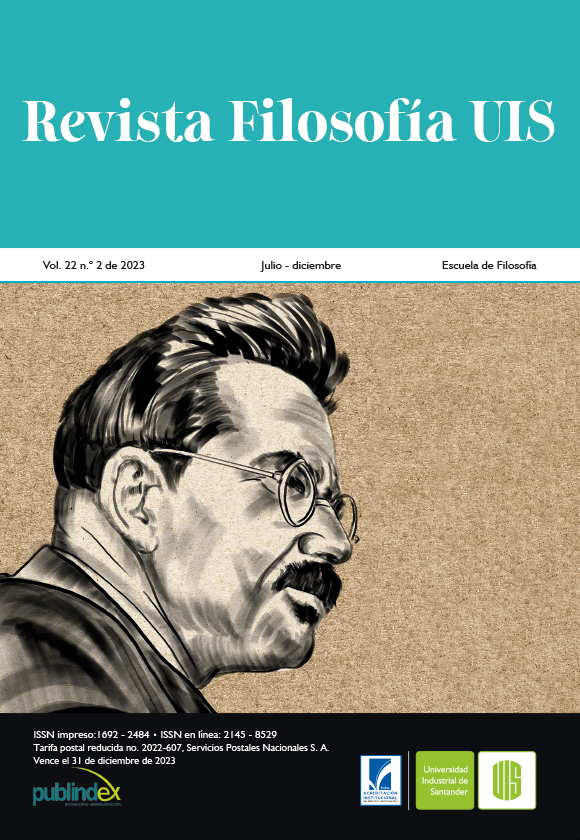To think about death (and laugh about it). Heracles’ speech (773-802) in Euripides’ Alcestis. A palinode?
Published 2023-07-04
Keywords
- Death,
- Tragedy,
- Satyr play,
- Alcestis,
- Euripides
- Heracles ...More
How to Cite
Copyright (c) 2023 Revista Filosofía UIS

This work is licensed under a Creative Commons Attribution 4.0 International License.
Abstract
One of the main debates around Euripides' Alcestis is its dramatic classification, because despite being represented in the place that a satyr play would have occupied, it does not have the characteristic elements of this genre, such as the chorus made up of satyrs, but it does has typical characteristics of a tragedy (structure, themes), while it has a happy ending in the style of a comedy. As Voelke (2015) points out, the essence of the encounter between tragedy and satyr play lies in the confrontation of life and death from which the play is structured. One of the elements in which this confrontation is condensed is Heracles's discourse on death (773-802), which seems to contain a philosophical vision of death. However, this speech is pronounced in the midst of drunkenness. Heracles himself is an ambiguous character who thrives in both tragedy and comedy, so much so that he can be considered the equivalent of Dionysus. Therefore, here we would like to explore to what extent, from this confluence of satirical and tragic elements, it is possible to find a conception of death in Heracles' speech.
Downloads
References
- Buxton, R. (2013). Myths and Tragedies in their Ancient Greek Contexts. Oxford University Press.
- Campbell, D. A. (Ed.). (1990). Greek Lyric: Vol. I. Harvard University Press.
- Castellani, V. (1979). Notes on the Structure of Euripides’ Alcestis. The American Journal of Philology, 100(4), 487–496. https://doi.org/10.2307/294062
- Conacher, D. J. (1988). Commentary. En D. J. Conacher (ed.), Eurpides Alcestis (pp. 155–199). Aris & Phillips Ltd.
- Dale, A. M. (Ed.). (2003). Euripides Alcestis. Bristol Classical Press.
- Dubois, C. (2019). Utilisation du matériau mythique et innovation : l’exemple des travaux d’Héraclès chez Euripide. Pallas, 109, 33-53. https://doi.org/10.4000/pallas.16377
- Euripides (1985). Tragedias: Vol. III (C. Garcia Gual y L. de Cuenca, eds.). Gredos.
- Eurípides (1991). Tragedias: Vol. I (A. Medina González y J. A. López Férez, eds.). Editorial Gredos.
- Euripides (2001). Cyclops, Alcestis, Medea (D. Kovacs, ed.). Harvard University Press.
- Fitzgerald, G. J. (1991). The Euripidean Heracles. An Intellectual and a Coward? Mnemosyne, 44(1/2), 85-95. http://www.jstor.org/stable/4432004
- Galinsky, G. K. (1972). The Herakles Theme. Rowman and Littlefield.
- Herrero de Jáuregui, M. (2016). The Meanings of σώιζειν in Alcestis’ Final Scene. Trends in Classics, 8(2), 205-225. https://doi.org/10.1515/tc-2016-0012
- Kratzer, E. (2020). Mortality is Hard to Wrestle With: Cosmology and Combat Sports in the Alcestis. Classics@ Journal, 13(1). https://classics-at.chs.harvard.edu/classics13-kratzer
- Luschnig, C. A. E., & Roisman, H. (2003). Notes and Commentary. En Euripides’ Alcestis (pp. 49–162). University of Oklahoma Press.
- Markantonatos, A. (2013). Euripides’ Alcestis. Narrative, Myth and Religion. De Gruyter.
- Marshall, C. W. (2000). Alcestis and the Problem of Prosatyric Drama. The Classical Journal, 95(3), 229-238. http://www.jstor.org/stable/3298192
- Martin, G. (2021). Nothing But Rhetoric? Rhetoric, Pragmatics And Myth-Making In The Agōn Of Euripides’ Alcestis.
- The Classical Quarterly, 71(2), 538–552. https://doi.org/10.1017/S0009838821000860
- Parker, L. P. E. (2007). Commentary. En Euripides Alcestis (pp. 47-285). Clarendon Press - Oxford University Press.
- Rehm, R. (1994). Marriage to Death. The Conflation of Wedding and Funeral Rituals in Greek Tragedy. Princeton University Press.
- Rodríguez Adrados, F. (Ed.). (1980). Lírica Griega Arcaica. Gredos.
- Roisman, H. (2002). Perspectives on Death in Euripides’ Alcestis. En R. Bouzón, P. Cavallero, A. Romano, & M. E.
- Steinberg (eds.), Los Estudios Clásicos ante el Cambio de Milenio. Vida, muerte, cultura: Vol. II (pp. 365–374). Facultad de Filosofía y Letras - UBA.
- Scodel, R. (1979). Αδμητου λογος and the Alcestis. Harvard Studies in Classical Philology, 83, 51–62. https://doi.org/10.2307/311095
- Seeck, G. A. (2008). Euripides Alkestis. De Gruyter.
- Segal, C. (1993). Euripides and The Poetics of Sorrow. Art, Gender and Commemoration in Alcestis, Hippolytus and Hecuba. Duke University Press.
- Slater, N. W. (2013). Euripides: Alcestis. Bloomsbury.
- Voelke, P. (2017). De la Mort a la Vie: Le “double chant” de L’Alceste de Euripide. Ordia Prima. Revista de Estudios Clásicos (Universidad Nacional de Córdoba), 14, 159–188.

